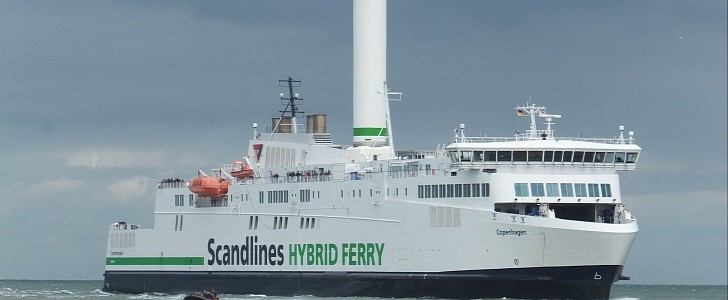On the path toward emissions-free operations, players in the maritime industry are betting not only on alternative fuels and hybrid-electric propulsion systems but also on wind power, one of the cleanest and widely-available sources of energy. Scandlines combined these solutions for one of its ferries and has now implemented them on a second one.
Scandlines is a well-known name in the industry, operating two ferry routes with a high capacity. Serious about becoming carbon-neutral by 2040, the company has been investing in hybrid technologies for almost a decade, either building or converting vessels into hybrid alternatives.
Two years ago, its hybrid ferry Copenhagen also got an advanced wind propulsion system. As a result, it has reduced CO2 emissions by 4%, and even up to 20% on the days with the best wind conditions, operating on the Rostock-Gedser route between Germany and Denmark.
After the successful feedback, it was now time for a second ferry to benefit from this modern sailing system. The Norsepower Rotor Sail was recently installed on the M/F Berlin in the port of Rostock, and the ferry soon resumed operations with its new addition.
As its name suggests, the Rotor Sail is a rotating cylinder that’s 30-meter-tall (98.4 feet). A modern version of the Flettner rotor, it uses the Magnus effect combined with a modern design.
The Magnus effect refers to the airflow accelerating on one side of the sail while decelerating on the other side. This leads to a pressure difference that results in a lift force that’s perpendicular to the direction of the wind. According to the manufacturer, this technology works best when the wind is perpendicular to the sail, at a speed of 20 m/s (44.7 mph).
The innovation of the modern version is that it’s fully automated, which means that it can measure the wind speed and direction at any moment and use that to calculate whether the use of the Rotor Sail would reduce emissions. If so, it automatically launches it. If not, the vessel continues to operate using only its hybrid propulsion system.
After implementing the Rotor Sail developed by Norsepower on the M/F Berlin, Scandline is now operating two hybrid ferries with a modern sail system between Germany and Copenhagen.
Two years ago, its hybrid ferry Copenhagen also got an advanced wind propulsion system. As a result, it has reduced CO2 emissions by 4%, and even up to 20% on the days with the best wind conditions, operating on the Rostock-Gedser route between Germany and Denmark.
After the successful feedback, it was now time for a second ferry to benefit from this modern sailing system. The Norsepower Rotor Sail was recently installed on the M/F Berlin in the port of Rostock, and the ferry soon resumed operations with its new addition.
As its name suggests, the Rotor Sail is a rotating cylinder that’s 30-meter-tall (98.4 feet). A modern version of the Flettner rotor, it uses the Magnus effect combined with a modern design.
The Magnus effect refers to the airflow accelerating on one side of the sail while decelerating on the other side. This leads to a pressure difference that results in a lift force that’s perpendicular to the direction of the wind. According to the manufacturer, this technology works best when the wind is perpendicular to the sail, at a speed of 20 m/s (44.7 mph).
The innovation of the modern version is that it’s fully automated, which means that it can measure the wind speed and direction at any moment and use that to calculate whether the use of the Rotor Sail would reduce emissions. If so, it automatically launches it. If not, the vessel continues to operate using only its hybrid propulsion system.
After implementing the Rotor Sail developed by Norsepower on the M/F Berlin, Scandline is now operating two hybrid ferries with a modern sail system between Germany and Copenhagen.






